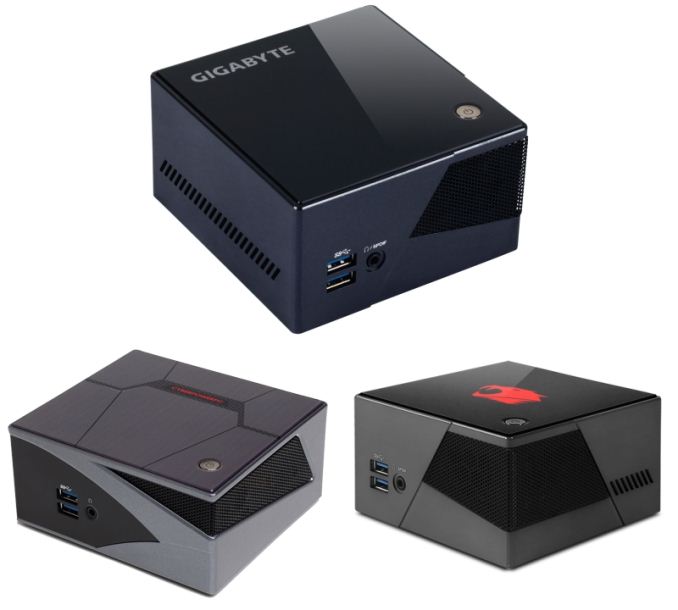GIGABYTE BRIX Pro: A Second Look at the Intel i7-4770R with Iris Pro HD 5200
by Ganesh T S on June 14, 2014 5:00 PM ESTConcluding Remarks
Intel's Core i7-4770R, despite being announced along with the rest of the Haswell family, had been impossible for consumers to source throughout 2013. Earlier this year, GIGABYTE became the first to come out with a PC based on that. The fact that they managed to cram the silicon into a NUC-sized motherboard in the BRIX Pro was no mean engineering feat.
After evaluating the BRIX Pro in detail over the last six months, we can say that it will turn out to be a trendsetter for compact gaming PCs. It has already made boutique PC vendors sit up and take notice. Recently, both iBUYPOWER and CyberPowerPC introduced SFF gaming PCs which use the BRIX Pro and provide consumers with options to complete the build (and create an off-the-shelf solution). In addition, GIGABYTE has already exhibited a number of different configurations in the same form factor.
However, with great power, we end up with much noise too. We simply can't recommend the unit for users who want a quiet HTPC for madVR capabilities or casual office work. But, the unit definitely excels as a compact machine for gaming with medium quality settings. In fact, it comprehensively beats what qualified as a bonafide mini-PC targeting gamers (the ASRock Vision 3D 252B) less than a couple of years ago. The powerful CPU makes sure that extensive multi-tasking as well as heavy duty office work can be carried out without any problems (as long as the acoustics are not a matter of concern). In terms of internal components, it is good to see that the 2.5" drive support is much easier to utilize compared to the Intel D54250WYKH NUC kit. We were a bit worried about the Realtek WLAN solution being foisted on consumers, but it turns out to be a surprisingly good performer (particularly with the Broadcom-based Netgear R7000 in our testbed).
On the whole, the GIGABYTE BRIX Pro has plenty going for it. The only aspect that we would like to see addressed in future versions is the thermal solution. Even while maintaining the same motherboard size, it might be possible to go in for a larger heat sink at the cost of increasing the unit's height. This might allow for better acoustics and extract even better performance from the processor by avoiding the throttling. In our opinion, the target market (gamers) would probably not mind it.











55 Comments
View All Comments
Dirk Broer - Sunday, June 22, 2014 - link
RAM speeds have a BIG impact on the performance of IGPs, both for Intel and AMD. Speed is even <a href="http://www.anandtech.com/show/7364/memory-scaling-... important</a> than Latency.Hrel - Monday, June 16, 2014 - link
Except that paying for that "faster" RAM costs you money and yields no tangible benefit beyond 1866. The price/performance sweet spot is 1866.http://www.anandtech.com/show/7364/memory-scaling-...
Dirk Broer - Sunday, June 22, 2014 - link
"you can easily get 2133 for a decent price" You've seen the photograph, with SoDIMMs? Where do you buy 2133 MHz SoDIMMS for a decent price?TwistedKestrel - Saturday, June 14, 2014 - link
I don't understand how graphics performance is worse if the RAM in the (2) is faster in every way. Even if you didn't use the XMP profile, it should still be faster!TwistedKestrel - Saturday, June 14, 2014 - link
I meant to say, worse in ANY scenario. The (2) should win out every time, not just some of the time.ganeshts - Saturday, June 14, 2014 - link
In areas where they are close or (1) wins out, the error is within measurement margin, but in the gaming scenarios where there is a big difference, (2) wins handsomely.Some benchmarks are also not dependent on the memory (CPU-bound).
Samus - Sunday, June 15, 2014 - link
It might be worth investigating whether the crystal well gpu can decrease CPU throughput when it is heavily taxed. That would explain why giving crystal well more memory bandwidth slightly decreases CPU performance. Although they are separate parts of the die, they communicate across the same bus and are flip-chip limited.etamin - Saturday, June 14, 2014 - link
My guess is that the difference is more related to thermals than RAM. Intel iGP's are less dependent on DRAM speeds than AMD's, especially the Crystal Well parts. Outside of the one Tomb Raider benchmark at 1080p, the performance drop isn't significant (at that FPS, it's all kind of irrelevant anyways). Since the max power draw is higher on the 2nd edition, it's probably attributed to a combination of silicon quality and throttling.dylan522p - Saturday, June 14, 2014 - link
Why did you use a 840 Evo. It is inferior to the MX100 which is also cheaper. For the same price you can get a drive with better nand and double the storage.ganeshts - Saturday, June 14, 2014 - link
Well, this piece has been in the works for a couple of months now.. When I built the refreshed config, the Samsung 840EVO was the best value for money.. I see that the MX100 came to market just a couple of weeks back..